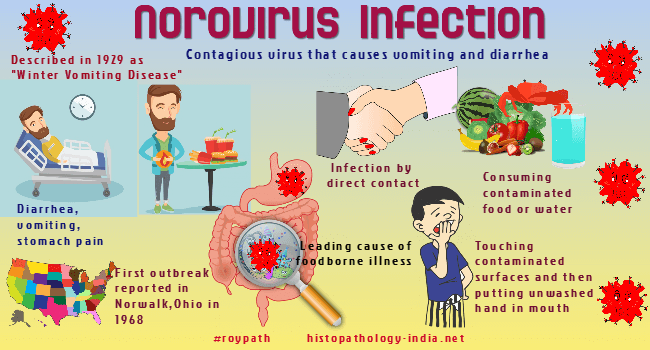|

Custom Search
|
|
Infectious Disease Online Pathology of Norovirus Infection
|

Human norovirus, previously known as Norwalk virus, was discovered in an outbreak of diarrhea and vomiting among the elementary school students in Norwalk, Ohio and was the first viral agent shown to cause gastroenteritis.Illness due to this virus was initially described in 1929 as “winter vomiting disease” due to its seasonal predilection and frequent presentation of patients with vomiting as a primary symptom. The virus has icosahedral symmetry, contain single-stranded RNA, and thought to be a Calicivirus.Noroviruses have been associated with gastroenteritis, primarily in adults and older children. Diarrhea and vomiting are of short duration, and dehydration is rare (as compared with rotavirus diarrhea ). The outbreaks have occurred at all times of the year and have been associated with contaminated water and foods (Example- Oysters) infected food-handlers, and person-to-person spread. Outbreaks have occurred in schools and college campuses, among families, in nursing homes, in communities with contaminated drinking or swimming water, and on cruise ships. Rotavirus and noroviruses multiply in epithelial cells lining villi of the small intestine, causing nonspecific inflammatory changes in the mucosa, including blunting of the villi, cytoplasmic vacuolization of epithelial cells, and a patchy, mononuclear, infiltrate of the lamina propria. The lysis of epithelial cells leaves the villi denuded and allows leakage of fluid and electrolytes into the lumen of the small intestine. Later there is contraction of denuded villi and transient replacement of mature, tall columnar epithelial cells by immature, cuboidal cells that migrate up from the crypts. Severe watery diarrhea and dehydration result from the decreased absorptive surface of the villi, decrease in the enzymatic activity of the brush border (including disaccharidases), and secretions by the immature crypt cells. Since the diet of young children is often based on milk, lactose malabsorption is of special concern. The diarrhea lasts only 1 to 3 days in most patients, and the intestinal mucosa is histologically normal within 3 to 4 weeks after onset of diarrhea. Histologic changes, however, persist in some children, especially among those less than 6 months old.
|
|
Further reading: Determination of the 50% human infectious dose for Norwalk virus. Laboratory evidence of norwalk virus contamination on the hands of infected individuals. |
|
|
Copyright © 2021 histopathology-india.net

